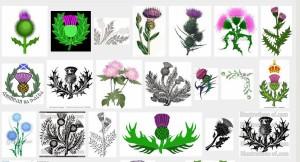Scotland's Purple Thistle

As many of you may know, the purple Thistle is Scotland's national flower. It was first adopted as the country's emblem during the reign of Alexander III (1249-1286). As legend goes, an invading Norse army attempted to sneak on Scottish shores unoticed one fateful night. One of the Norsemen, who was walking barefoot, had the misfortune of stepping on a Thistle, making him cry out in pain and consequently alerting the Scots of their presence. Sources suggest this happened during the Battle of Largs.
In honour of this victory, the plant became known as the Guardian Thistle and subsequently the national symbol of Scotland. The earliest official recorded use of the Thistle flower was on silver coins issued in 1470 during the reign of James III. It was then incorporated into the Royal Arms of Scotland in the early 16th century.
Another legend associated with this prickly flower is that of the noble Order of the Thistle. King Achius is said to have founded the Order in the 9th century, consisting of 13 Knights including himself. The main emblems are the Thistle and St Andrew holding a saltire. Their motto is Nemo me impune lacessit (Latin for "No one provokes me with impunity"). Although it has had its ups, downs and changes throughout history, the Order is now firmly anchored in Edinburgh's St Giles Cathedral.
Biologically speaking, this lovely flower thrives in most of the Scottish territories, especially in the Highlands. This proud and regal plant can grow to a height of five feet and has no natural enemies because of the vicious spines that cover and protect it. Just like the country it represents, it is of a dramatic beauty like no other!

 Check out our Yopto Reviews
Check out our Yopto Reviews
